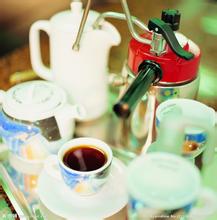Starbucks Coffee Baking Curve Flavor description processing method Taste characteristics Variety Manor introduction
In the old work "the Collection of Fine Coffee", all kinds of coffee beans are divided into four types according to their characteristics. To put it simply, from soft A-type coffee beans of low real estate to hard D-type coffee beans of high land are distinguished in different colors, indicating the baking method and baking degree consistent with their type.
For example, coffee beans from highlands such as Kenya and Colombia are classified as type D because of their thick meat, large grains and high water content. Type D coffee beans have poor heat permeability and strong sour taste, so it is not suitable to adopt the baking degree of "light baking to moderate roasting" like type A. It is more suitable for "medium-deep baking to deep baking" which will produce a strong bitter taste.
What would happen if type D coffee beans from Kenya or Colombia were roasted with shallow roasting similar to type A? I'm afraid the heat can't penetrate the bean core, producing a "sour taste" mixed with bitterness and acid. Nor can it lead to its inherent bitterness and mellowness. In this way, the rare Kenyan or Colombian coffee beans will be wasted and end up in vain.
In order to reduce even a little of this "useless work", I figured out a baking table named "systematic Coffee" (see table below). If you use this summary table, you won't make the stupid mistake of using the shallow roasting of roasted A-type coffee beans to bake hard D-shaped coffee beans. Each kind of coffee bean has its own suitable or unsuitable baking degree. Making delicious coffee with obviously unsuitable roasting degrees is nonsense.
The most suitable baking degree varies depending on the type of coffee beans. Someone asked me how to find the most suitable baking degree. My answer is "can only be inferred in my own way", and I must also learn the "basic baking" learning program. The learning method is to roughly fry coffee beans from Cuba or Ethiopia to Italian deep-roasting (Italian Roast), test the taste at the prescribed baking stage and keep it in mind.
At first, it can be divided into four stages: shallow baking, moderate baking, medium-depth baking and deep baking. After the habit, there are 8 stages, 16 stages, and sometimes subdivided into 24 stages and 32 stages, which are confirmed by cup testing as the taste changes from very shallow baking (Light Roast) to very deep baking. This is the "basic roasting" of Baja Coffee (Taguchi's cafe in Japan).

Important Notice :
前街咖啡 FrontStreet Coffee has moved to new addredd:
FrontStreet Coffee Address: 315,Donghua East Road,GuangZhou
Tel:020 38364473
- Prev

Coffee beans AA grade AAA coffee is based on what grade? What are the characteristics?
Buy coffee beans should pay attention to choose products with QS certification, now the country has included coffee beans into the scope of enforcement, if there is no QS, it means that this product is not in line with food safety regulations. 2 about coffee grease: coffee is damp, Italian coffee beans should have oil itself. The law of fat is as follows: the surface of fresh, medium-and deep-roasted coffee beans will
- Next

The principle that coffee flowers need to be foamed without flowers is how to construct them to make them look good.
The first step is to understand the correct operation flow of the steam system of the coffee machine, understand the purpose of the empty steam pipe before and after foam, and understand the importance of towels and easy cleaning in coffee making. The second step is to learn how to use the sprinkler to touch the milk surface, the location and depth of the selected point. The third step is to recognize the two temperatures.
Related
- What brand of black coffee is the most authentic and delicious? what are the characteristics of the flavor of the authentic Rose Summer Black Coffee?
- Introduction to the principle and characteristics of the correct use of mocha pot A detailed course of mocha pot brewing coffee is described in five steps.
- Which is better, decaf or regular coffee? how is decaf made?
- How much is a bag of four cat coffee?
- How about four Cat Coffee or Nestle Coffee? why is it a cheap scam?
- Which is better, Yunnan four Cats Coffee or Nestle Coffee? How about cat coffee? is it a fake scam? why is it so cheap?
- How about Cat Coffee? what grade is a hoax? which instant coffee tastes better, four Cat Coffee, Nestle Coffee or G7 coffee?
- Process flow chart of coffee making-Starbucks coffee making process what coffee tastes good at Starbucks
- The top ten best coffee beans in the world Rose summer coffee or Tanzanian coffee tastes good
- Yunnan four cat coffee is good to drink?_four cat coffee is a big brand? four cat blue mountain coffee is fake?

